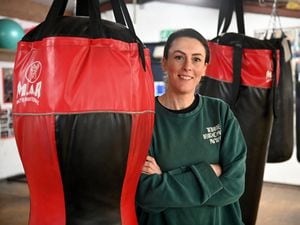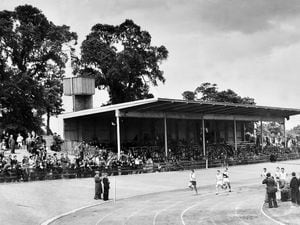World's first football superstar: Goal sensation who became a real trailblazer
He had a record the likes of Kane, Rooney and Lineker would envy. We remember the West Midlands legend Steve Bloomer.

Harry Kane, 48 goals in 67 appearances for England. That's a strike rate of 71 per cent. Pretty prolific.
Wayne Rooney, 53 goals in 120 games, or 44 per cent, not bad. Gary Lineker, 48 goals in 80, about 60 per cent. That's also pretty good, but they're not exactly Steve Bloomer, are they?
The Black Country son of an iron 'puddler' holds the record that beats them all. He only played 23 times for England, they didn't play so many games in his day, but he scored an incredible 28 goals. That's a goalscoring ratio of 121 per cent. Steve Bloomer's name on the team-sheet was better than giving England a goal start in every game.
Steve who? OK, we are going back in time a bit here. It is 130 years since Bloomer made his professional debut for Derby County, and his England career stretched from 1895 to 1907. But we will probably never see his like again.
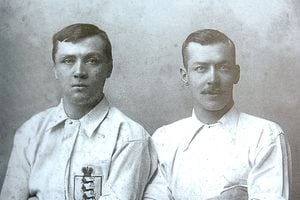
His club record was almost as remarkable, scoring 350 goals in 598 games – a record bettered only by Jimmy Greaves, who managed 357 goals.
Often described as football's "first superstar", in many ways he blazed a trail for the modern footballer. While, like all footballers in his day, his wages were capped to a level little more than the average factory worker, Bloomer made a fortune from corporate sponsorship. When his playing career was over, the tried his hand at club management on the continent – although he would live to regret taking up that post at Berlin, which landed him in jail when the First World War broke out.
He was also an impressive cricketer, baseball player, sprint-runner and cribbage player. Bloomer's picture adorned a mural on the Queen Mary when she made her maiden voyage, and he is even name-checked in a novel by P G Wodehouse.
But, in an age when even the most elite of footballers tended to stay local, the likes of Villa, Wolves, Albion and maybe even Shrewsbury Town must rue the decision by Bloomer's father Caleb to improve the family's circumstances by moving to Derby.
Yet despite being the most famous sports star of his day, he did not look like the archetypal pin-up. Average height, slim build, the most remarkable of his appearance was the lack of colour in his cheeks.
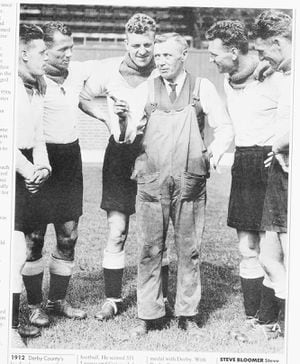
Frederick Wall, secretary of the FA at the time, remarked: "His pale face was a mystery to me. Some thought that his pallor was due to physical weakness, but this was an idea that his vitality and endurance, maintained for years, abundantly disproved. I often thought ... that this sickly cast of countenance was caused by anxiety and the way he taxed his nervous energy, for he was often deadly serious."
Yet Bloomer's impact on popular culture during the 1890s and 1900s was truly immense. Football historian Paul Topliff, who runs a website dedicated to the player, says: “Bloomer’s name was associated with promotional campaigns on an international scale.
"He was associated with clothing, footwear, books, magazines, tonics, tobacco and photography.
"He was used to endorse ‘Phosphoric Tonic – the Remedy of Kings’. He appeared on 19 different cigarette cards and had his own Steve Bloomer-endorsed ‘Lucky Striker’ football boots, as well as ‘Perfegrippe’, renowned for being the first moulded-stud boot, still being sold the world over more than 40 years after his death.”
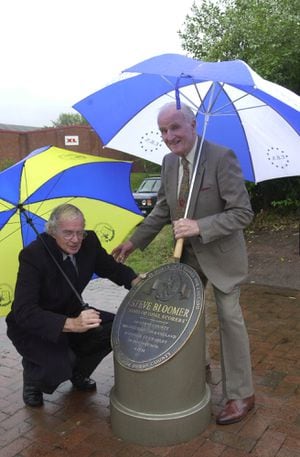
Stephen Bloomer was born on January 20, 1874, in Bridge Street, just south of the River Stour in the small Black Country town of Cradley – not the larger town of Cradley Heath as is sometimes erroneously reported. The house he was born in has long disappeared, but was finally recognised in 2000 when a memorial plaque was installed by former Wolves and Derby player Jimmy Dunn and Bloomer's grandson Steve Richards.
His parents, Caleb and Merab, were both the offspring of nailmakers, but Caleb earned a living as a blacksmith and a 'puddler'. Puddling was one of the toughest and most dangerous jobs in the Black Country at the time, involving the purification of crude pig iron into wrought iron by melting it, and stirring iron oxide powder into the liquid with a fork. The strenuous labour, the heat and fumes meant puddlers frequently died in their 30s, so it is perhaps no great surprise that Caleb sought a move away.
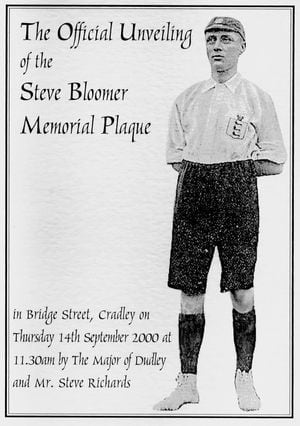
Steve was five years old when the Bloomers relocated to Derby, his father taking a job at the Ley's Malleable Castings foundry. The company's owner, Sir Francis Ley also owned a plot of land which was initially used to host baseball matches, and the site – which would later become home to Derby County FC – became known as the Baseball Ground.
Steve attended St James's School in the town where he demonstrated an aptitude for football. But when he left school in 1886 at the age of 12, it looked like he would be following in his father's footsteps when he took a job as a 'striker' to a blacksmith, working at the forge.
He also began playing his trade as a striker outside work, initially playing for the St Chad's Choir football team.
At the age of 16, while still working at Leys, he joined Derby Swifts, where he remained for three years, playing in the Derbyshire Minor League. On December 20, 1890, he scored seven goals in a 22-2 drubbing away to Belper Town, and he claimed to have scored 14 in another match.
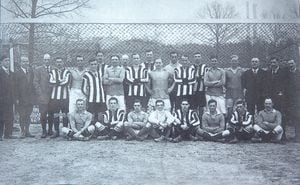
This inevitably attracted the attention of Swifts' larger neighbours Derby Midland, and Bloomer made his debut in a 1-1- draw with Burton Swifts on March 27, 1891. Three months later Derby Midland were then taken over by Derby County, and Bloomer started the 1891-92 season – the fourth season of the Football League – as a Derby County player.
Bloomer initially turned down the offer of a professional contract though, as he wanted to continue playing for Derby Swifts as well. He finally signed as a professional on April 28, 1892, for the princely sum of 7s 6d a week – about £50 a week at today's prices.
Yet his first-team debut came only as the result of an accident. An administrative error by Derby secretary William Parker meant that star players Ernest Hickinbottom, Jimmy McLachlan and Samuel Mills were all ineligible for the opening game of the 1892-93 season, a September 3 trip to Stoke's Victoria Ground. And it is fair to say he seized the opportunity with relish. Whether he scored once, as reported in some of the local papers, or twice – as he claimed – is the subject of some debate, but there is no doubt that he stole the show, helping Derby to an impressive 3-1 victory.
In his first season he scored 11 goals in 28 appearances, making him County's second-leading goalscorer, and he was still only 19. For the rest of his Derby County career, he would be their leading goalscorer for every single season.
His second season for Derby was marred by injury, with Bloomer missing seven games after Leicester Fosse half-back Peggy Lord broke his collarbone during a goalless draw on February 10, 1894. Nevertheless, he still managed 19 goals from 27 appearances.
The 1894-95 campaign was a tough one for Derby, with the Rams finishing second from bottom of the First Division. This meant a final-day play-off against Notts County, who finished second in the new Second Division. With seven minutes to go, Derby looked certain for relegation, but snatched a late equaliser before Bloomer snatched a winner in the dying seconds.
Bloomer opened the 1895–96 season by scoring both goals in a 2–0 win over Sunderland in the club's new permanent home at the Baseball Ground. Bloomer was the First Division's joint leading scorer, tied on 22 goals with Aston Villa's John Campbell. And Bloomer's goals helped Derby finish the season in second place, pipped to the title by Villa.
The next season was even better for Bloomer, who scored 31 goals, including five hat-tricks, His most goals in one game came in January, 1899, when he put six past Sheffield Wednesday.
He also became the first player to score at West Bromwich Albion's new home The Hawthorns when he returned to the Black Country on September 3, 1900, although the Baggies at least managed to snatch an equaliser to pick up a point.
Despite his prodigious talent in front of goal, he would have to wait two-and-a-half years for his first England appearance. He made his international debut at Derby County's home ground on March 9, 1895, where he scored twice and set up another in a 9-0 trouncing of Ireland.
Bloomer only found himself on the losing side twice in a 12-year international career, and even on those occasions – both against Scotland – he got on the scoresheet. He is one of only four England players to score five goals in an international match, against Wales, in 1896, and he also scored four goals against Wales in 1901.
He captained England just once, in a game that didn't count – the infamous Ibrox disaster, when a stand collapsed and the game was replayed.
Derby fans were shocked in 1905 when Bloomer was sold to Middlesbrough for £750, and the team was relegated at the end of the season. He quickly established himself as Middlesbrough's leading scorer, scoring 62 goals in 130 appearances, but a chance meeting with Derby's manager at Middlesbrough station in 1910 saw Bloomer return to Derby at the age of 36.
He picked up where he left off, captaining the Rams to the Second Division title. He remained with Derby for another three years, finally retiring around the time of his 40th birthday in January 1914.
While it was probably time for Bloomer to hang up his boots, his first foray into football management would prove something of a disaster.
In July 1914 he took up the post as coach of Britannia Berlin 92, but within three weeks the First World War broke out. When Germany declared war on Russia, his contract was cancelled at once, and the club president advised Bloomer to get out of Germany as quickly as possible.
Britain declared war on Germany on August 5, and the following day Bloomer tried to visit the British Consul office in Berlin to facilitate his escape. But before he arrived, he was stopped by two police officers, and with about a dozen others, he was marched at gunpoint through the streets of Berlin to the Alexander Platz, where he was arrested. He was initially granted bail, but on November 5 he was arrested again and detained as a prisoner of war at Ruhleben detention centre in Spandau.
He was not the only footballer at Ruhleben, with other inmates including his Wolverhampton-born former Middlesbrough team-mate Fred Pentland, and his former England colleague Sam Wolstenholme. Also incarcerated were Scottish international John Cameron, former Everton and Tottenham player John Brearley and German international Edwin Dutton, who had previously played for Britannia Berlin 92.
A Ruhleben Football Association was formed, and cup and league competitions were organised with as many as 1,000 prisoners attending the bigger games. The teams adopted the names of established teams and in November 1914, Bloomer captained a Tottenham Hotspur XI, that also included Dutton, to victory in a cup final against an Oldham Athletic XI. On May 2, 1915, an England XI featuring Pentland, Wolstenholme, Brearley and Bloomer played a World XI captained by Cameron.
In summer the prisoners turned to cricket on "The Oval", playing to packed houses. Bloomer established the camp batting record with an innings of 204 and recorded bowling figures of six for 15. He also won the 'Old Age Handicap' at the Ruhleben Olympics, sprinting the 75 yards in 9.6 seconds.
Speaking of his time at the camp, Bloomer later said: "Myself and many others would not have survived without football."
During his time in prison, one of his daughters died at the age of 17.
When Bloomer was released to neutral Holland in March, 1918, a farewell football match was staged in his honour. Not allowed to return to the UK until the end of the war, he took up the post of coach at Blauw-Wit Amsterdam.
He returned to Derby County to coach, and occasionally play for the club's reserves. In 1922 he briefly went to Canada to coach the Grenadier Guards team, and he also coached Spanish side Real Union to win the 1924 Copa del Rey. He then returned to Derby, where he spent the rest of his life as a general assistant-cum-groundsman at the Baseball Ground.
Bloomer's wife Sarah died in 1934, and by this time the player's own health was in decline, probably a consequence of his time as a prisoner in Germany. A testimonial organised by Derby County paid for him to go on a therapeutic cruise, but it failed to solve his problems. He died of bronchitis on April 16, 1938.
At the unveiling of Bloomer's memorial plaque in Cradley, in September 2000, his grandson Steve Richards fondly remembered the frail man who would watch him play football in the park.
"Although he achieved fame outside the Black Country, he was always proud of his Cradley roots," he said.
Nobody alive today will have seen Steve Bloomer in his pomp, and there is no film footage of any of his goals. Nevertheless, at every home game Derby County fans start with a chorus of "Steve Bloomer's Watching", ensuring the legend will never die. A legend that was very much made in the Black Country.
Steve Bloomer facts
Steve Bloomer scored a total of 378 goals in 621 games, comprising 28 goals for England, 291 for Derby County and 59 for Middlesbrough. His England tally was finally surpassed by Nat Lofthouse in 1956, but Bloomer's goal-per-game ratio has never been equalled.
Born in Bridge Street, Cradley, on January 20, 1874, the son of 'puddler' Caleb Bloomer and his wife Merab.
The Bloomers moved to Derby in 1879, and Steve left school at the age of 12, joining his father a couple of years later at Leys foundry.
Bloomer signed for Derby County in 1891, initially as an amateur, making his full debut the following year, on the opening day of the season.
In 1895 he made his England debut, scoring in a 3-0 win over Scotland. He claimed a second, but it was given as an own goal.
Bloomer signed for Middlesbrough in 1905, returning to Derby in 1910. At the age of 38 he managed 14 goals in 30 games, including two hat-tricks.
He retired as a player in January 1914, at the age of 40.
Bloomer took on the role as manager of Britannia Berlin 92 in 1914, but was arrested on the outbreak of war.
He was held at Ruhleben detention camp in Spandau until March, 1918, where he was released to neutral Holland.
Bloomer briefly coached Blauw-Wit Amsterdam before returning to Derby.
He died from bronchitis on April 16, 1938, aged 64.

